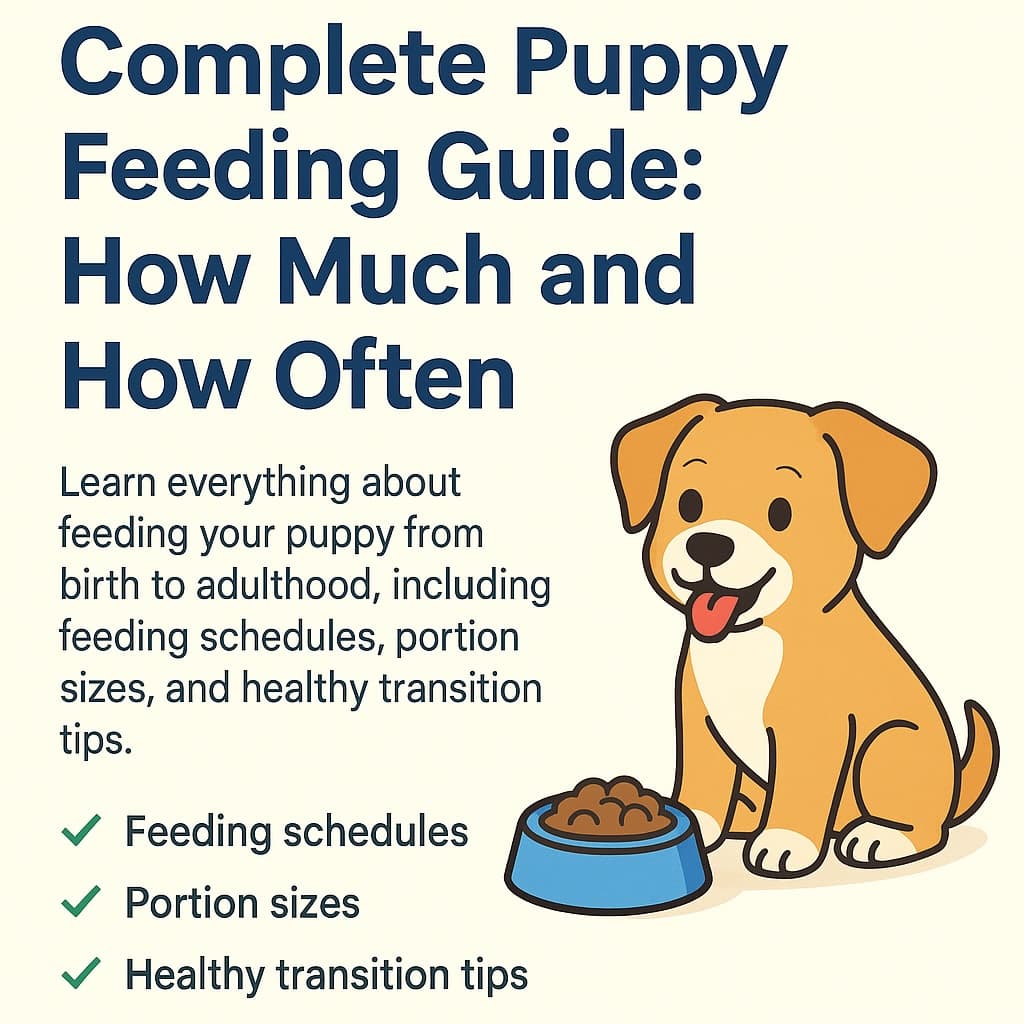Complete Puppy Feeding Guide: How Much and How Often
Learn everything about feeding your puppy from birth to adulthood, including feeding schedules, portion sizes, and healthy transition tips.
Feeding a puppy properly is one of the most important things you can do for their long-term health and development. Unlike adult dogs, puppies have rapidly changing nutritional needs that require careful attention and adjustment as they grow.

Complete visual guide to puppy feeding schedules and portion sizes by age and breed
Key Takeaways
- • Puppies need 2-3x more calories per pound than adult dogs
- • Feeding frequency decreases as puppies age (4x daily → 2x daily)
- • Large breed puppies need special food to prevent bone problems
- • Always transition foods gradually over 7-10 days
Understanding Puppy Nutritional Needs
Puppies need significantly more calories per pound of body weight than adult dogs because they're growing rapidly and have higher metabolic rates. Generally, puppies need about 2-3 times more calories per pound than adult dogs of the same weight.
Key Nutritional Requirements for Puppies:
Feeding Schedule by Age
0-8 WeeksMother's Milk or Formula
During the first 8 weeks, puppies should ideally nurse from their mother. If nursing isn't possible, use a high-quality puppy milk replacer. Never use cow's milk, as it can cause digestive upset.
8-12 WeeksIntroduction to Solid Food
This is when puppies start transitioning to solid food. Feed 4 times per day with small, frequent meals. Soften dry puppy food with warm water initially to make it easier to eat.
3-6 MonthsRapid Growth Phase
Continue feeding 3-4 times daily. This is a critical growth period, especially for large breed puppies. Monitor weight gain carefully and adjust portions as needed.
6-12 MonthsGradual Reduction
Most puppies can transition to 2-3 meals per day. Small breeds may reach adult size by 8-10 months, while large breeds continue growing until 12-18 months.
Large Breed Puppy Special Note: Large breed puppies (expected adult weight over 50 lbs) should be fed large breed puppy food with controlled calcium levels to prevent developmental orthopedic diseases.
How Much to Feed
The amount varies greatly based on breed, size, and individual metabolism. Start with the feeding guidelines on your puppy food package, but be prepared to adjust based on your puppy's body condition.
General Guidelines by Expected Adult Size:
Small Breeds
(under 25 lbs adult)
1/4 to 1 cup daily
divided into meals
Medium Breeds
(25-60 lbs adult)
1 to 2.5 cups daily
divided into meals
Large Breeds
(over 60 lbs adult)
2 to 4+ cups daily
divided into meals
Signs You're Feeding the Right Amount
✅ Good Signs
- •Steady, appropriate weight gain
- •Can feel ribs easily but they're not visible
- •Visible waist when viewed from above
- •Good energy levels
- •Healthy coat and skin
⚠️ Warning Signs
- •Ribs not easily felt (may be overfeeding)
- •Ribs clearly visible (may be underfeeding)
- •Excessive weight gain or loss
- •Lethargy or hyperactivity
- •Digestive issues
Transitioning to Adult Food
Most dogs should transition to adult food when they reach about 80% of their expected adult size. This happens at different ages depending on breed size:
Small breeds
8-10 months
Medium breeds
10-12 months
Large breeds
12-18 months
Giant breeds
18-24 months
Transition Tip: When switching to adult food, do it gradually over 7-10 days by mixing increasing amounts of adult food with decreasing amounts of puppy food.
Common Puppy Feeding Mistakes
❌ Free feeding
Leaving food out all day can lead to overeating
❌ Too many treats
Treats should be less than 10% of daily calories
❌ Human food
Many human foods are toxic to dogs
❌ Inconsistent schedule
Regular meal times help with house training
❌ Wrong food type
Adult food doesn't meet puppy nutritional needs
When to Consult Your Veterinarian
Always consult with your vet about your puppy's feeding plan, especially if you notice:
- ⚠️Sudden changes in appetite
- ⚠️Rapid weight gain or loss
- ⚠️Digestive issues
- ⚠️Signs of food allergies
- ⚠️Questions about transitioning foods
Remember: Every puppy is unique. These guidelines provide a starting point, but your veterinarian's advice should always take precedence for your specific puppy's needs.
Use Our Calculator for Adult Dogs
Once your puppy reaches adulthood, you can use our dog food calculator to determine the right amount of food for their adult needs. The calculator takes into account weight, size, activity level, and food type to provide accurate feeding recommendations.
Ready to Calculate Adult Portions?
Get personalized feeding recommendations for your adult dog
Try Our Dog Food Calculator